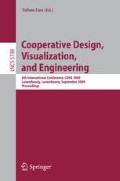Abstract
The literature on spatial environments concerns many disciplines, and the present study aims at broadly contributing from an urban-planning view. Indoor and outdoor townscapes, because of their dynamic complexity, seem to offer ill-structured holds to the typical spatial behaviour of an agent. Therefore, a question arises about the ‘fundamentals’ of spacescapes from the point of view of the needs of living and moving agents.
Following this thread, the paper deals with the diagnosis and the control of a structured simple space, a minimum arc of a graph. Conditions, situations, elements, behaviours are explored in their spatial-temporal dimensions, subsequently aiming at setting up a system architecture to let spatial agents control their de-structuring impact.
Text analysis and interpretation are applied to a questionnaire survey, exploring low level (movement orientation) and high level (memories and fantasies) behaviours in human interaction with a space. The experiment is developed in a large class of students from the Technical University of Bari, daily using a long and apparently amorphous corridor to reach professors’ offices for explanations.
The present study was carried out by the authors as a joint research work. Nonetheless, chapter 2 was written by D. Borri, chapters 1, 3, 4 and 5 were written by D. Camarda. The authors are grateful to A. Celino and M.Patano for their support, help and critical contribution to the review of the paper.
Access this chapter
Tax calculation will be finalised at checkout
Purchases are for personal use only
Preview
Unable to display preview. Download preview PDF.
References
Aboutalib, S., Veloso, M.: Towards Using Multiple Cues for Robust Object Recognition. In: AAMAS 2007, Honolulu, Hawaii, May 14–18 (2007)
Courrieu, P.: Function Approximation on non-Euclidean Spaces. Neural Networks 18, 91–102 (2005)
Danziger, D., Rafal, R.: The Effect of Visual Signals on Spatial Decision Making. Cognition 110, 182–197 (2009)
de Hevia, M.D., Spelke, E.S.: Spontaneous Mapping of Number and Space in Adults and Young Children. Cognition 110, 198–207 (2009)
Denis, M., Michon, P.E., Tom, A.: Assisting Pedestrian Wayfinding in Urban Settings: Why References to Landmarks are Crucial in Direction-Giving. In: Allen, G.L. (ed.) Applied Spatial Cognition: From Research to Cognitive Technology, pp. 25–51. Erlbaum, Mahwah (2006)
Ferber, J.: An Introduction to Distributed Artificial Intelligence. Addison-Wesley, London (1999)
Fischer, J.: Citizens, Experts, and the Environment: The Politics of Local Knowledge. Duke University Press, Durham (2000)
Garling, T., Evans, G.W. (eds.): Environment, Cognition, and Action: An Integrated Approach. Oxford University Press, New York (1991)
Gero, J.S., Tversky, B. (eds.): Visual and Spatial Reasoning in Design. Key Centre of Design Computing and Cognition. University of Sydney (1999)
Gillner, S., Weiss, A.M., Mallot, H.A.: Visual Homing in the Absence of Feature-Based Landmark Information. Cognition 109, 89–104 (2008)
Golledge, R.G. (ed.): Wayfinding: Cognitive Mapping and Other Spatial Processes, pp. 125–151. Johns Hopkins, Baltimore (1999)
Goodman, N.: The Structure of Appearance. Harvard UP, Cambridge (1951)
Hartley, T., Trinkler, I., Burgess, N.: Geometric Determinants of Human Spatial Memory. Cognition 94, 39–75 (2004)
Hayes, P.: The Second Naive Physics Manifesto. In: Hobbs, J.R., Moore, R.C. (eds.) Formal Theories of the Common Sense World, pp. 1–36. Ablex Publishing Corporation, Norwood (1985)
Hirtle, S.C.: Neighborhoods and Landmarks. In: Duckham, M., Goodchild, M.F., Worboys, M.F. (eds.) Foundations of Geographic Information Science, pp. 191–230. Taylor & Francis, London (2003)
Kelly, D.M., Bischof, W.F.: Orienting in Virtual Environments: How Are Surface Features and Environmental Geometry Weighted in an Orientation Task? Cognition 109, 89–104 (2008)
Lew, A.R., Foster, K., Bremner, J.G., Green, M., Slavin, S.: Detection of Geometric but not Topological Transformations in 6-12-Month-Old Infants in a Visual Exploration Paradigm. Developmental Psychobiology 47, 31–42 (2005)
Lynch, K.: The Image of the City. The MIT Press, Cambridge (1960)
Mockler, R.J.: Knowledge-Based Systems for Management Decisions. Prentice-Hall, Upper Saddle River (1989)
Tversky, B., Hard, B.M.: Embodied and Disembodied Cognition: Spatial Perspective-Taking. Cognition 110, 124–129 (2009)
Warren, T., Gibson, E.: The Influence of Referential Processing on Sentence Complexity. Cognition 85, 79–112 (2002)
Weyns, D., Omicini, A., Odell, J.: Environment as a First Class Abstraction in Multiagent Systems. Autonomous Agent and Multi-Agent Systems 14, 5–30 (2007)
Author information
Authors and Affiliations
Editor information
Editors and Affiliations
Rights and permissions
Copyright information
© 2009 Springer-Verlag Berlin Heidelberg
About this paper
Cite this paper
Borri, D., Camarda, D. (2009). The Cooperative Conceptualization of Urban Spaces in AI-Assisted Environmental Planning. In: Luo, Y. (eds) Cooperative Design, Visualization, and Engineering. CDVE 2009. Lecture Notes in Computer Science, vol 5738. Springer, Berlin, Heidelberg. https://doi.org/10.1007/978-3-642-04265-2_29
Download citation
DOI: https://doi.org/10.1007/978-3-642-04265-2_29
Publisher Name: Springer, Berlin, Heidelberg
Print ISBN: 978-3-642-04264-5
Online ISBN: 978-3-642-04265-2
eBook Packages: Computer ScienceComputer Science (R0)

